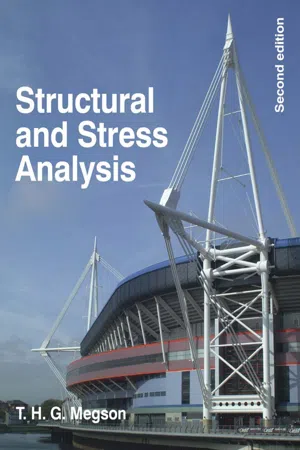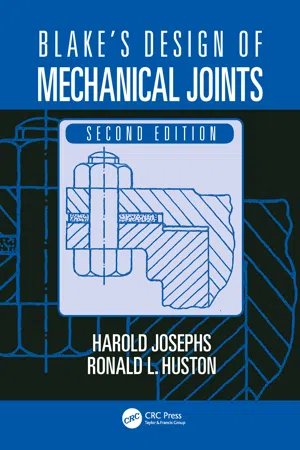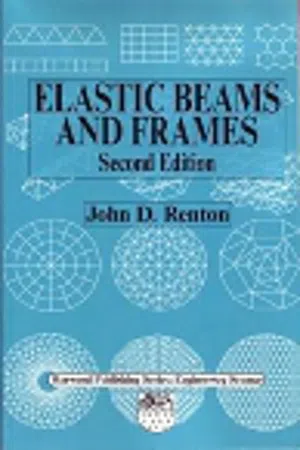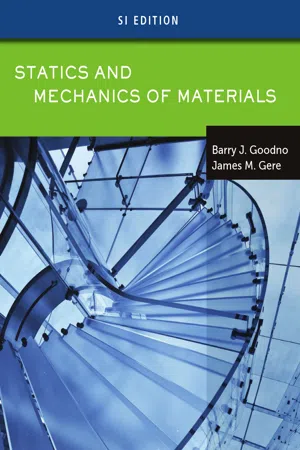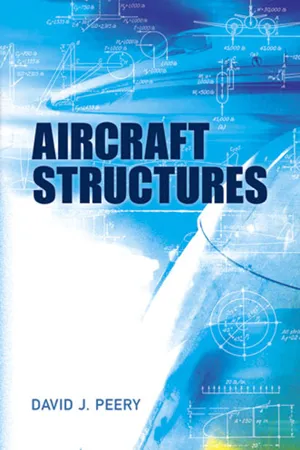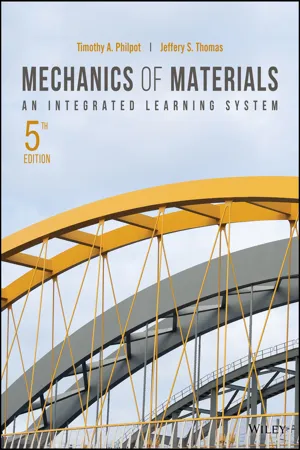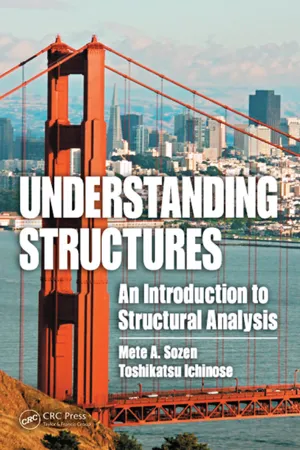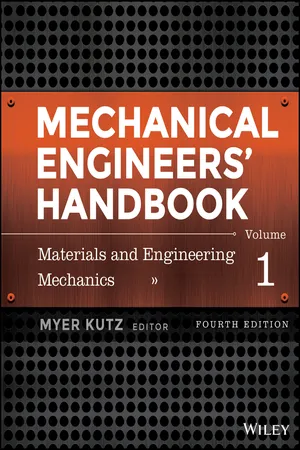Technology & Engineering
Shear Stress in Beams
Shear stress in beams refers to the force that causes one layer of the beam to slide relative to an adjacent layer. It is a result of the internal forces within the beam and is important for determining the beam's strength and stability. Shear stress is a critical consideration in the design and analysis of beams in engineering and construction.
Written by Perlego with AI-assistance
Related key terms
1 of 5
11 Key excerpts on "Shear Stress in Beams"
- eBook - ePub
- Robert L. Mott, Joseph A. Untener(Authors)
- 2021(Publication Date)
- CRC Press(Publisher)
8 Shearing Stresses in BeamsThe Big Picture8–1 Objectives of This Chapter8–2 Importance of Shearing Stresses in Beams8–3 General Shear Formula8–4 Distribution of Shearing Stress in Beams8–5 Development of the General Shear Formula8–6 Special Shear Formulas8–7 Design for Shear8–8 Shear FlowThe Big Picture Discussion Map-
In Chapter 8 , your goal is to continue to develop your ability to analyze and design beams, but now in terms of shearing stresses that occur as a result of bending loads.
-
For a beam to be safe, it must satisfy design stress limits for both bending stresses and shearing stresses . In most cases, the bending stress is the most critical. But shearing stresses must always be checked, and as discussed in Section 8–2 , there are some important situations where shearing stresses are the predominant mode of failure.
-
You’ve already studied vertical shearing forces, but if a small stress element subjected to such shearing stresses is isolated, as shown in Figure 8–3 , it can be seen that horizontal shearing stresses must also exist in order to cause the element to be in equilibrium. Thus, both vertical and horizontal shearing stresses, having the same magnitude at a given point, are created by shearing stresses in beams.
The last few chapters have led to the analysis and design of beams loaded in bending with regard to normal stresses, that is tension and compression. For most beams, normal stress is the most likely to cause failure. Some beams, however, are susceptible to failure in shear - Available until 4 Dec |Learn more
Design-Tech
Building Science for Architects
- Thomas Leslie, Robert Whitehead, Rob Whitehead, Jason Alread(Authors)
- 2014(Publication Date)
- Routledge(Publisher)
Chapter 24 .Internal Resistance to Shear
Besides bending, beams must also be designed with a resistance against shear failure. Shear force deforms an object's shape by attempting to make adjacent planes within a structure slide past each other. Shear stress can be found in many different situations and scales: a bolted connection between two members sliding with respect to each other, at the conjunction of a column and slab, in the diagonal cracking of a compressive element, or even in the behavior of a simple paper punch.There are two types of possible shear in beams, vertical shear or horizontal shear. Horizontal shear is the tendency of materials to slide in layers relative to each other—in practice, it is rarely is a concern unless the material used for the spanning member was weakly laminated longitudinally (like early glu-lam wooden structures). Horizontal shear might best be envisioned as the mechanism that ties the foreshortened compression edge of a beam to the elongated tension edge. In other words, horizontal shear is the result of the internal “force couple” that resists bending. Vertical shear is caused by the opposing vertical forces of the loads and supports trying to slice through the beam material (see Figure 22.4 of a beam with horizontal boxes and layers).22.4 Vertical and horizontal shear failures.Shear failure is typically a concern for beams at, or near, its supports because the reaction force and loading are pushing in opposite directions in close proximity to each other. Interestingly, however, shear failure is rarely manifest as either a purely horizontal or vertical fracture—instead, most shear failures occur diagonally. This behavior can be attributed to the combined effect of both horizontal and vertical shear forces acting simultaneously in a beam. This behavior is best described by selecting a random square area from the side elevation of a beam and looking at how these shear forces acting in concert attempt to distort, or skew, its shape (Figure 22.5 - eBook - PDF
- T.H.G. Megson(Author)
- 2005(Publication Date)
- Butterworth-Heinemann(Publisher)
C h a p t e r 10 / Shear of Beams In Chapter 3 we saw that externally applied shear loads produce internal shear forces and bending moments in cross sections of a beam. The bending moments cause direct stress distributions in beam sections (Chapter 9); we shall now determine the corre-sponding distributions of shear stress. Initially, however, we shall examine the physical relationship between bending and shear; the mathematical relationship has already been defined in Eq. (3.8). Suppose that a number of planks are laid one on top of the other and supported at each end as shown in Fig. 10.1(a). Applying a central concentrated load to the planks at mid span will cause them to bend as shown in Fig. 10.1(b). Due to bending the underside of each plank will stretch and the topside will shorten. It follows that there must be a relative sliding between the surfaces in contact. If now the planks are glued together they will bend as shown in Fig. 10.2. The glue has prevented the relative sliding of the adjacent surfaces and is therefore subjected to a shear force. This means that the application of a vertical shear load to a beam not only produces internal shear forces on cross sections of the beam but shear forces on horizontal planes as well. In fact, F IGURE 10.1 Bending of unconnected planks (a) (b) F IGURE 10.2 Bending of connected planks 250 10.1 Shear Stress Distribution in a Beam • 251 we have noted this earlier in Section 7.3 where we saw that shear stresses applied in one plane induce equal complementary shear stresses on perpendicular planes which is exactly the same situation as in the connected planks. This is important in the design of the connections between, say, a concrete slab and the flange of a steel I-section beam where the connections, usually steel studs, are subjected to this horizontal shear. Shear stress distributions in beam cross sections depend upon the geometry of the beam section. - eBook - ePub
- Harold Josephs, Ronald L. Huston(Authors)
- 2018(Publication Date)
- CRC Press(Publisher)
There are several reasons for this: First, textbook examples generally have relatively simple shapes—often different and far simpler in complexity than components typically found in “real-world” mechanical systems. Secondly, the issues of safety and economic concerns are seldom considered in text problems. Finally, tables of material values typically represent optimal values at a single measured point, assuming no defects in the materials, nor any difference for other values in the spectrum beyond the specific point measured.The literature on structural analysis and mechanics of materials contains a number of stress definitions and descriptive terms such as: “direct stress,” “bending,” “flexure,” “torsion,” “twist,” “transverse shear,” “ultimate stress,” “principal stress,” “primary,” or “secondary stresses” and others. In reality, however, there can only be two basic kinds of stress: normal and shear when we consider a state of stress at a given point of a mechanical system. At a given cross-sectional plane of a structure the normal stress is, of course, that which is perpendicular to that plane, while the shear stress acts along the given plane. In a simple beam, loaded in the transverse direction (perpendicular to the long axis of the beam), the normal stress is that which is perpendicular to the transverse cross-section or, in other words, the normal stress is directed along the axis of the beam. We recall that a simple beam is considered to be a 2-D component.The familiar bending stress of σ = MC /I , known to design engineers, is simply a normal stress at the section where the bending stress is considered. The transverse stress at this location, on the other hand, is the shear stress which acts at 90° to the normal stress just described. These two stresses, of course, can be combined according to a suitable strength of materials theory depending on the type of stresses and the materials from which the component is made.For example, if the material is brittle, we will initiate our analysis by first examining the maximum normal stress in our failure considerations. Alternatively, if the material is ductile, we will focus upon the shear stresses. We will discuss failure in greater detail later in this chapter. - eBook - PDF
- J D Renton(Author)
- 2002(Publication Date)
- Woodhead Publishing(Publisher)
Chapter 6 Shear of Beams 6.1 Introduction In Chapter 4, shear forces acting on beams were seen to produce varying flexural curvature and hence varying bending stresses. More complete analyses include the shear deformation and shear stresses produced by such loading. In thin-walled beams, it is usually sufficient to determine the response from the mean shear flow (cf 45.3 and 85.9) but as with torsion, there is a more exact theory due to Saint-Venant. In general, a shear force acting on a beam will produce torsion as well as bending. The sense of this torsion will depend on the position of the line of action of the shear force relative to the cross-section of the beam. If this line of action passes through the shear centre of the beam, there is no tendency for the force to twist it either way. Conversely, if a pure torque is applied to the beam, its cross-section tends to twist about this shear centre. Were this not so, a shear force acting through the shear centre would do work during torsion, which would mean that it had a torsional effect on the beam. The deformation of a beam caused by a shear force means that plane cross-sections no longer remain plane. This has implications on defining what is meant by the rotation of a beam's cross-section and the nature of support conditions. Because the beam's cross-section can no longer be considered rigid, it is necessary to consider what meaning should be attached to its overall rotation and displacement. To choose the rotation and displacement at the centroid, for example, is arbitrary. Also, the use of a simple average rotation and displacement can lead to inconsistencies. Later in this chapter and in the general theory expounded in Chapter 8, work and energy principles will be employed. 6.2 The Engineering Theory of Shear of Thin-Walled Sections From $4.2 it follows that the resultant shear force S produces a rate of change of bending stress a. - Barry Goodno, James Gere(Authors)
- 2018(Publication Date)
- Cengage Learning EMEA(Publisher)
For a typical wood beam, the allowable stress in horizontal shear is in the range of 4 to 10% of the allowable bending stress. Consequently, even though the maximum shear stress is relatively low in value, it sometimes governs the design. Copyright 2019 Cengage Learning. All Rights Reserved. May not be copied, scanned, or duplicated, in whole or in part. Due to electronic rights, some third party content may be suppressed from the eBook and/or eChapter(s). Editorial review has deemed that any suppressed content does not materially affect the overall learning experience. Cengage Learning reserves the right to remove additional content at any time if subsequent rights restrictions require it. 758 Chapter 10 Stresses in Beams (Basic Topics) The shear stresses in the web of a wide-flange beam act only in the vertical direction and are larger than the stresses in the flanges. These stresses can be found by the same techniques used for finding shear stresses in rectangular beams. Shear Stresses in the Web Begin the analysis by determining the shear stresses at line ef in the web of a wide-flange beam (Fig. 10-37a). Make the same assumptions as those made for a rectangular beam; that is, assume that the shear stresses act parallel to the y axis and are uniformly distributed across the thickness of the web. Then the shear formula VQ Ib / 5 will still apply. However, the width b is now the thickness t of the web, and the area used in calculating the first moment Q is the area between line ef and the top edge of the cross section (indicated by the shaded area of Fig. 10-37a). When finding the first moment Q of the shaded area, disregard the effects of the small fillets at the juncture of the web and flange (points b and c in Fig. 10-37a). The error in ignoring the areas of these fillets is very small.- eBook - ePub
- David J. Peery(Author)
- 2013(Publication Date)
- Dover Publications(Publisher)
CHAPTER 6SHEAR AND BENDING STRESSES IN SYMMETRICAL BEAMS
6.1. Flexure Formula. After finding the values of the shear and bending moment at a cross section of a beam, it is necessary to find the unit stresses on the cross section in order to design the beam. The unit stress is the force intensity at any point, and has units of force per unit area, or pounds per square inch (psi) in common engineering units. Where the term stress is used in future discussion, it will be assumed to mean unit stress . In this chapter, it will be assumed that the beam cross section is symmetrical about either a horizontal or a vertical axis through its centroid, so that these axes will be principal axes. The stresses resulting from axial forces, shearing forces, and bending moments will be computed separately and superimposed.FIG . 6.1.An initially straight beam is deflected to a circular arc when loaded in pure bending as shown in Fig. 6.1 . It has been found experimentally that a plane cross section of the beam remains plane after bending. The cross sections AB and CD shown in Fig. 6.1 would both be vertical planes before bending, and would become radial planes after bending. If the beam is considered as made up of longitudinal “fibers,” the fibers in the upper part of the beam will be compressed and those in the lower part will be stretched. The fibers on some intermediate surface, called the neutral surface , will remain the same length. The intersection of the neutral surface and any cross section is called the neutral axis for the cross section. If cross sections AB and CD are originally a unit distance apart, the unit elongation e of any fiber between these cross sections is shown in Fig. 6.1 as the distance from plane CD of the deformed beam to a plane C ′D ′ which is parallel to plane AB . The unit elongation e is proportional to the distance y of the fiber from the neutral surface, regardless of the relationship between the unit stress and the unit elongation for the material. If the stress is below the elastic limit for the material, the stress is proportional to the strain, and consequently proportional to the distance y - eBook - PDF
Mechanics of Materials
An Integrated Learning System
- Timothy A. Philpot, Jeffery S. Thomas(Authors)
- 2020(Publication Date)
- Wiley(Publisher)
(This notion was intro- duced previously in Section 1.5, pertaining to axial members, and in Section 6.4, regarding torsion members.) Consequently, the expression “maximum shear stress,” when applied to beams, could be interpreted to mean either a. the maximum value of τ = VQ/It for any coordinate y in the cross section, or b. the maximum shear stress at a particular point in the cross section when all possible plane surfaces that pass through the point are considered. In this chapter, to preclude ambiguity, the expression “maximum horizontal shear stress” will be used in a context in which the maximum value of = VQ/It for any coordinate y in the cross section is to be determined. Since shear stresses on perpendicular planes must be equal in magnitude, it would be equally proper to use the expression “maximum transverse shear stress” for this purpose. In Chapter 12, the notion of stress transformations will be used to determine the maximum shear stress at a particular point. In Chapter 15, maximum normal and shear stresses at specific points in beams will be discussed in more detail. (9.5) (9.6) 286 CHAPTER 9 Shear Stress in Beams EXAMPLE 9.2 A 10 ft long simply supported laminated wooden beam consists of eight 1.5 in. by 6 in. planks glued together to form a section 6 in. wide by 12 in. deep, as shown (Figure 1). The beam carries a 9 kip concentrated load at midspan. Determine a. the average horizontal shear stress in the glue joints at b, c, and d, and b. the maximum horizontal shear stress in the cross section, at section a–a, located 2.5 ft from pin support A (Figure 2). Plan the Solution The transverse shear force V acting at section a–a can be determined from a shear- force diagram for the simply supported beam. To determine the horizontal shear stress in the indicated glue joints, the corresponding first moment of area, Q, must be calculated for each location. - eBook - PDF
- Barry Goodno, James Gere, Barry Goodno(Authors)
- 2020(Publication Date)
- Cengage Learning EMEA(Publisher)
Cengage Learning reserves the right to remove additional content at any time if subsequent rights restrictions require it. 516 Chapter 5 Stresses in Beams (Basic Topics) *5.12 Beams with Axial Loads Structural members are often subjected to the simultaneous action of bending loads and axial loads. This happens, for instance, in aircraft frames, columns in buildings, machinery, parts of ships, and spacecraft. If the members are not too slender, the combined stresses can be obtained by superposition of the bending stresses and the axial stresses. To see how this is accomplished, consider the cantilever beam shown in Fig. 5-47a. The only load on the beam is an inclined force P acting through the centroid of the end cross section. This load can be resolved into two com- ponents, a lateral load Q and an axial load S. These loads produce stress resultants in the form of bending moments M, shear forces V , and axial forces N throughout the beam (Fig. 5-47b). On a typical cross section a distance x from the support, these stress resultants are M Q L x V Q N S ( ) 5 2 5 2 5 in which L is the length of the beam. The stresses associated with each of these stress resultants can be determined at any point in the cross sec- tion by means of the appropriate formula ( / My I s 5 2 , / VQ Ib t 5 , and / N A s 5 ). Since both the axial force N and bending moment M produce normal stresses, combine those stresses to obtain the final stress distribution. The axial force (when acting alone) produces a uniform stress distribution / N A s 5 Substituting V , Q, and I into the shear-flow formula [Eq. (5-57)] gives f VQ I (10,500 N)(864 10 mm ) 264.2 10 mm 34.3 N/mm 3 3 6 4 5 5 3 3 5 which is the horizontal shear force per millimeter of length that must be transmitted between the flange and the two webs. - eBook - PDF
Understanding Structures
An Introduction to Structural Analysis
- Mete A. Sozen, Toshikatsu Ichinose(Authors)
- 2018(Publication Date)
- CRC Press(Publisher)
In this section we exam-ine shear-stress distribution on a beam section. Before tackling the problem of shear-stress distribution over a beam section, we need to develop a set of definitions for stresses. Figure 4.4.2a shows an infinitesimal cube that is subjected to four stresses acting on the top face ADEH and side face ABEF. Axis x is perpendicular to face ABEF, and axis y is perpendicular to face ADEH. We focus on four stresses (also see Table 4.4.1 ): s : the normal stress acting in the direction of the x-axis on face ABEF s y : the normal stress acting in the direction of the y-axis on face ADEH t xy : the shear stress acting in the direction of the y-axis on face ABEF t yx : the shear stress acting in the direction of the x-axis on face ADEH The stresses s x and s y are called normal stresses because they act in a direction perpendicular to the faces of the cube ( Table 4.4.1 ). The stresses t xy and t yx , acting in x y σ x σ y D C B F E H x y z σ x σ x σ y σ y A B C D A B C D τ yx (a) Infinitesimal cube x y (b) Normal stress (c) Shear stress τ xy τ vx τ xy τ yx τ xy A FIGURE 4.4.2 Stresses on an infinitesimal cube. Direction of Force Direction of face x x y y Shear stress Normal stress τ xy τ yx (= τ xy ) σ x σ y TABLE 4.4. 1 Nomenclature for Normal and Shear Stresses 220 Understanding Structures: An Introduction to Structural Analysis directions parallel to the faces of the cube, are called shear stresses. Generally, there are normal as well as shear stresses on the face ABCD; but for simplicity we shall ignore them in order to be able to show them in two dimensions ( Figure 4.4.2b , c ). In Figure 4.4.2b , note that the equilibrium of forces requires a stress of s x on face DC and a stress of s y on face BC in the opposite direction to the normal stresses on faces AB and AD. In Figure 4.4.2c , similarly, t xy and t yx act on faces DC and BC. The equilibrium condition for moment leads to the following important equation. - eBook - ePub
Mechanical Engineers' Handbook, Volume 1
Materials and Engineering Mechanics
- Myer Kutz(Author)
- 2015(Publication Date)
- Wiley(Publisher)
A beam. is selected tentatively and checked for shear. Maximum shearing stress (horizontal and vertical) is at the neutral surface over the supports. Equation (34) for horizontal shear in a solid rectangular beam is, and, when. If the safe horizontal unit shearing stress for common-grade southern yellow pine is 88 psi and since the actual horizontal unit shearing stress is less than 88 lb, the. beam will be satisfactory. A beam of uniform strength is one in which the dimensions are such that the maximum fiber stress is the same throughout the length of the beam. The form of the beam is determined by finding the areas of various cross sections from the flexure formula, keeping constant and making I / c vary with. For a rectangular section of width and depth, the section modulus, and, therefore,. By making vary with, the dimensions of the various sections are obtained. Table 6 gives the dimensions and at any section, the maximum unit fiber stress, and the maximum deflection y of some rectangular beams of uniform strength. In this table, the bending moment has been assumed to be the controlling factor. On account of the vertical shear near the ends of the beams, the area of the sections must be increased over that given by an amount necessary to keep the unit shearing stress within the allowable unit shearing stress. The discussion of beams of uniform strength, although of considerable theoretical interest, is of little practical value since the cost of fabrication will offset any economy in the use of the material. A plate girder in a bridge or a building is an approximation in practice to a steel beam of uniform strength. Table 6 Rectangular Beams of Uniform Strength a 6.3 Continuous Beams As in simple beams, the expressions and govern the design and investigation of beams resting on more than two supports. In the case of continuous beams, however, the reactions cannot be obtained in the manner described for simple beams
Index pages curate the most relevant extracts from our library of academic textbooks. They’ve been created using an in-house natural language model (NLM), each adding context and meaning to key research topics.


